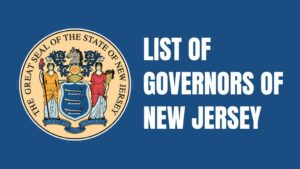Louisiana’s rich political tapestry is woven with the threads of its governors’ diverse legacies. From the early days of colonial rule to the contemporary era, these leaders have shaped the state’s destiny, navigating through periods of upheaval, transformation, and progress. In this article, we will explore the list of Louisiana Governors.
List of Louisiana Governors
Here is a simplified list of Louisiana Governors:
- William C.C. Claiborne
- Jacques Villeré
- Thomas Bolling Robertson
- Henry S. Thibodaux (Acting)
- Henry Johnson
- Pierre Derbigny
- Armand Beauvais (Acting)
- Jacques Dupré
- André B. Roman
- Edward Douglass White Sr.
- Alexandre Mouton
- Isaac Johnson
- Joseph Walker
- Paul O. Hébert
- Robert C. Wickliffe
- Thomas Overton Moore
- Michael Hahn
- James Madison Wells
- Benjamin Flanders
- Henry Clay Warmoth
- P.B.S. Pinchback (Acting)
- John McEnery (Disputed)
- William Pitt Kellogg
- Francis T. Nicholls
- Samuel D. McEnery
- Murphy J. Foster
- William W. Heard
- Newton C. Blanchard
- Jared Y. Sanders Sr.
- Luther E. Hall
- Ruffin G. Pleasant
- John M. Parker
- Huey P. Long
- Alvin O. King (Acting)
- Oscar K. Allen
- James A. Noe (Acting)
- Richard W. Leche
- Earl K. Long
- Sam H. Jones
- Jimmie H. Davis
- Robert F. Kennon
- John J. McKeithen
- Edwin Edwards
- David C. Treen
- Buddy Roemer
- Mike Foster
- Kathleen Blanco
- Bobby Jindal
- John Bel Edwards
William C.C. Claiborne (1812-1816):
William Charles Cole Claiborne was the first governor of Louisiana after it was admitted as a state to the Union. Before serving as governor, he was the territorial governor, overseeing the transition of Louisiana from a French colony to an American territory. His governorship laid the foundational policies and structures of the new state’s government.
Jacques Villeré (1816-1820):
Jacques Philippe Villeré was the second governor of Louisiana and the first Creole governor. Villeré had served in the militia during the Battle of New Orleans. His governorship is notable for addressing the challenges of integrating Louisiana’s diverse population into the American political and legal systems.
Thomas Bolling Robertson (1820-1824):
Serving after Villeré, Robertson focused on the state’s fiscal health and advocated for infrastructure improvements. His tenure saw efforts to stabilize the state’s finances and promote economic development.
Henry S. Thibodaux (Acting) (1824):
Henry S. Thibodaux served briefly as acting governor following the resignation of Thomas Bolling Robertson. His short tenure was marked by a continuation of the policies of his predecessor, without significant changes or developments.
Henry Johnson (1824-1828, 1834-1838):
Henry Johnson served two non-consecutive terms as governor. He is known for his efforts to improve Louisiana’s infrastructure, including levee construction and navigation improvements. His leadership also focused on the state militia and defense.
Pierre Derbigny (1828-1829):
Pierre Derbigny’s term as governor was cut short by his death in a carriage accident. During his brief tenure, he worked on legal reforms and advocated for the codification of Louisiana’s laws, continuing the state’s unique blend of French civil law and American common law.
Armand Beauvais (Acting) (1829):
Armand Beauvais served as acting governor for a brief period after the death of Pierre Derbigny. His term was marked by political instability and a contentious relationship with the legislature.
Jacques Dupré (1830-1831):
Jacques Dupré’s administration focused on state financial matters and the improvement of Louisiana’s public education system. He worked towards stabilizing the state’s economy and advocating for laws that supported education.
André B. Roman (1831-1835, 1839-1843):
André Bienvenu Roman is notable for serving two non-consecutive terms. His governorship was marked by efforts to improve state infrastructure, including education, roads, and levees, and he is remembered for his moderate and stabilizing influence in Louisiana politics.
Edward Douglass White Sr. (1835-1839):
The father of a future U.S. Supreme Court Chief Justice, Edward Douglass White Sr.’s term focused on economic issues and the abolition of imprisonment for debt. His administration dealt with the challenges of state debt and sought to promote economic stability.
Alexandre Mouton (1843-1846):
Alexandre Mouton served as governor during a period of economic transition and bank reforms in Louisiana. A supporter of states’ rights and the slave economy, Mouton’s administration faced challenges related to state finances and banking reforms. He later served as a delegate to the secession convention, playing a role in Louisiana’s decision to secede from the Union.
Isaac Johnson (1846-1850):
Isaac Johnson’s term as governor is noted for his efforts to improve state infrastructure, particularly in the realm of education and transportation.
Joseph Walker (1850-1853):
During Joseph Walker’s governorship, the focus was on continuing the development of Louisiana’s infrastructure, including railroads and public institutions. His administration dealt with the complexities of state debt and economic development in a pre-Civil War society.
Paul O. Hébert (1853-1856):
Paul Octave Hébert’s term was marked by his efforts to address the issues of levee construction and maintenance, crucial for flood control and agricultural development in the state. His administration also faced challenges related to sectional tensions and the debate over slavery.
Robert C. Wickliffe (1856-1860):
Robert Charles Wickliffe’s governorship occurred during a period of increasing national tension over slavery and states’ rights. Wickliffe was known for his pro-slavery stance and worked to maintain the institution of slavery in Louisiana, as well as focusing on infrastructure and state development.
Thomas Overton Moore (1860-1864):
Serving as governor during the critical period of the Civil War, Thomas Overton Moore led Louisiana through its secession from the Union and the subsequent challenges of wartime.
Michael Hahn (1864-1865):
Michael Hahn was appointed governor during the Civil War by President Abraham Lincoln, serving in a Union-controlled portion of Louisiana.
James Madison Wells (1865-1867):
James Madison Wells became governor during the tumultuous Reconstruction era, succeeding Hahn. His term was marked by significant challenges, including efforts to rebuild the state’s economy and infrastructure, navigate the complex politics of Reconstruction, and address the rights of newly freed African Americans.
Benjamin Flanders (1867-1868):
Appointed by the federal government during Reconstruction, Flanders was a moderate Republican who focused on rebuilding Louisiana’s economy and integrating freed slaves into society.
Henry Clay Warmoth (1868-1872):
Warmoth, a Republican, was elected during the Reconstruction era. His administration worked on establishing public education and improving infrastructure.
P.B.S. Pinchback (Acting) (1872-1873):
Pinckney Benton Stewart Pinchback served as acting governor, becoming the first African American to serve as governor of a U.S. state, albeit for a brief period. His tenure was an important symbol of the progress made during Reconstruction, though he faced significant opposition.
John McEnery (Disputed) (1873):
John McEnery’s election was marked by controversy and violence, leading to the Colfax Massacre, one of the deadliest instances of racial violence during Reconstruction.
William Pitt Kellogg (1873-1877):
A Republican and ally of President Ulysses S. Grant, Kellogg’s term was characterized by continued efforts to enforce Reconstruction policies. His administration faced violent opposition, notably the White League’s attempts to overthrow Republican rule.
Francis T. Nicholls (1877-1880, 1888-1892):
Nicholls, a Democrat, took office as federal troops were withdrawn from Louisiana, marking the end of Reconstruction. His administration focused on restoring Democratic control and rolling back many Reconstruction-era reforms.
Samuel D. McEnery (1881-1888):
The brother of John McEnery, Samuel McEnery’s term continued the Democratic dominance in Louisiana politics, emphasizing state development and economic growth while navigating the complexities of post-Reconstruction society.
Murphy J. Foster (1892-1900):
Foster’s administration solidified white Democratic control over Louisiana politics, implemented policies that disenfranchised many African American voters, and promoted agricultural and economic development.
William W. Heard (1900-1904):
During Heard’s governorship, Louisiana continued to focus on economic development, including improvements to public health systems and educational institutions. His administration also saw efforts to combat yellow fever and promote public health.
Newton C. Blanchard (1904-1908):
Blanchard’s term as governor was marked by a focus on education and infrastructure development, including road and school improvements. His administration sought to modernize Louisiana while dealing with the state’s social and economic issues.
Jared Y. Sanders Sr. (1908-1912):
Sanders’ administration was notable for the adoption of the state’s “good roads” amendment, leading to significant improvements in Louisiana’s road network. He also worked on educational reform and promoting agricultural development.
Luther E. Hall (1912-1916):
Hall’s governorship focused on fiscal reform and anti-corruption measures, including the establishment of a state-wide tax commission to assess and collect taxes more effectively. His tenure aimed at improving state governance and reducing political corruption.
Ruffin G. Pleasant (1916-1920):
Pleasant’s governorship was marked by his involvement in World War I efforts, promoting patriotism and supporting military preparations. His administration also faced issues related to prohibition and women’s suffrage, reflecting the national debates of the time.
John M. Parker (1920-1924):
As governor, Parker focused on progressive reforms, including anti-corruption measures and public health initiatives. Despite facing opposition from the powerful Louisiana political machine, his administration made strides in education and infrastructure improvements.
Huey P. Long (1928-1932):
One of the most colourful and influential figures in Louisiana’s history, Huey P. Long’s governorship was characterized by his populist and authoritarian style. Long implemented massive public works projects, expanded social services and effectively took control of the state’s political machine. His legacy is a complex blend of significant achievements and controversial tactics.
Alvin O. King (Acting) (1932):
Serving briefly as acting governor after Huey Long’s election to the U.S. Senate, King’s tenure was largely a continuation of Long’s policies, focusing on maintaining the momentum of the Long political machine’s initiatives.
Oscar K. Allen (1932-1936):
As a close ally of Huey Long, Allen saw his governorship as an extension of Long’s influence, even while Long served in the Senate. Allen continued Long’s policies of improving infrastructure and social programs, but Long’s assassination in 1935 overshadowed his term.
James A. Noe (Acting) (1936):
James A. Noe served as acting governor for a brief period. His administration was a transitional phase in Louisiana politics, coming after the death of Huey Long and continuing the policies set forth by Long and his successors.
Richard W. Leche (1936-1939):
Leche’s tenure as governor continued the dominance of the Long political machine, but it was marred by corruption and scandal. His resignation amid accusations of misappropriation of funds marked the beginning of the end for the Long era’s unchecked power.
Earl K. Long (1939-1940, 1948-1952, 1956-1960):
The younger brother of Huey Long, Earl K. Long served three non-consecutive terms as governor. He was a skilled political operator, known for his populist policies, colorful personality, and efforts to expand social services. His tenure also saw the beginning of the civil rights movement’s impact on Louisiana politics.
Sam H. Jones (1940-1944):
Sam Jones was elected on a platform of reform and anti-corruption, aiming to clean up the state government after the scandals of the Leche administration. His tenure focused on transparency, fiscal conservatism, and the dismantling of the Long political machine’s control over state politics.
Jimmie H. Davis (1944-1948, 1960-1964):
Best known for his song “You Are My Sunshine,” Jimmie Davis served two non-consecutive terms as governor. His administrations were marked by a mix of progress in education and healthcare, with a conservative approach to civil rights and social issues. Davis’ tenure reflected the political and social complexities of mid-20th century Louisiana.
Robert F. Kennon (1952-1956):
Kennon’s administration focused on anti-corruption efforts and fiscal conservatism, contrasting with the populist legacies of the Longs. His tenure saw improvements in the state’s infrastructure and a push for a more business-friendly environment, aiming to attract investment to Louisiana.
John J. McKeithen (1964-1972):
McKeithen, serving during a tumultuous period marked by the civil rights movement, is remembered for the phrase “Louisiana is a state of law and order.” His administration worked towards economic development and was notable for promoting industrial growth and improving race relations, despite the challenging national climate.
Edwin Edwards (1972-1980, 1984-1988, 1992-1996):
Edwards, a charismatic and controversial figure, served four terms as governor, making him one of the most prominent politicians in Louisiana’s history.
David C. Treen (1980-1984):
Treen was the first Republican governor of Louisiana since Reconstruction, signalling a shift in the state’s political landscape. His term focused on economic issues, including attempts to diversify the state’s economy beyond oil and gas.
Buddy Roemer (1988-1992):
Roemer’s governorship was characterized by reform efforts aimed at improving Louisiana’s fiscal health, education system, and environmental policies. He faced significant challenges, including a budget crisis and political opposition, which hindered some of his reform initiatives.
Mike Foster (1996-2004):
Foster’s tenure as governor focused on education reform, including the creation of the Louisiana Community and Technical College System and the introduction of the TOPS scholarship program, aimed at improving access to higher education for Louisiana students. His administration also worked on economic development and environmental conservation.
Kathleen Blanco (2004-2008):
Blanco was the first woman to serve as Louisiana’s governor. Her term was dominated by the catastrophic impacts of Hurricanes Katrina and Rita in 2005. Blanco faced significant challenges in the disaster’s aftermath, focusing on the state’s recovery and rebuilding efforts. Her leadership during this period received mixed reviews.
Bobby Jindal (2008-2016):
Jindal’s governorship was marked by a focus on ethics reform, economic development, and health care policy. He implemented significant tax cuts and worked towards making the state more attractive for business investment. Jindal also faced criticism for his handling of the state’s budget and public services.
John Bel Edwards (2016-present at last update):
Edwards, a Democrat in a predominantly Republican state, has focused on Medicaid expansion, which provided healthcare access to hundreds of thousands of Louisianans. His administration has also dealt with several natural disasters, focusing on emergency response and recovery efforts.
Conclusion:
The lineage of Louisiana’s governors reflects the state’s dynamic history and its ongoing journey towards progress and resilience. As stewards of Louisiana’s future, they embody the spirit of adaptation and innovation that has always characterized this vibrant state. Get more information on Copypastequickly.
FAQ
Who was the first governor of Louisiana?
The first governor of Louisiana under U.S. rule was William C.C. Claiborne, serving from 1803 to 1816, first as a territorial governor and then as the state’s first official governor after statehood in 1812.
How has the role of Louisiana’s governors changed over time?
Over time, the role of Louisiana’s governors has evolved from primarily administrative duties under colonial rule to dynamic leadership positions, shaping state policies, navigating crises, and representing Louisiana on the national stage.
What impact did Huey Long have on Louisiana?
Huey Long, one of Louisiana’s most famous governors, dramatically impacted the state through his populist policies, infrastructure projects, and charismatic, albeit controversial, leadership style.
Related Post:




